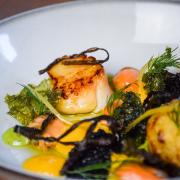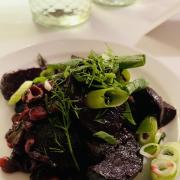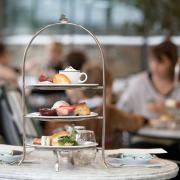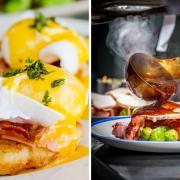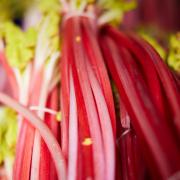Hungry households are falling in love with meat as the cookbooks come out once again

At Hutchinson Hobbs farm shop near Yarm, butcher Barry Hutchinson is lucky to get as much as a bacon butty to eat during the day. His five-strong team in the shop’s butchery has never been as busy, and demand doesn’t look to be waning.
Barry is working on plans for the shop’s expansion alongside a business that has rocketed at the family farm shop since lockdown, so much so that he has taken on a further four members of staff to deal with trade that has more than doubled in the past two months.
‘In what I call ‘panic week’, when lockdown was announced, we had 2,500 customers compared with an average of 1100 a week,’ he says. Since then it has levelled to 1600-1800 customers.
‘We are in the shop about 6.30am and doing 11–12 hour days, then sometimes until 9pm or 10pm at night. We haven’t seen what I would call panic buying, rather, people buying for others while they are here.

‘Meat sales have more than doubled and people are spending 50–60 per cent more.’ he says.
He believes customers are buying in to the provenance of their supplies and feel more secure in the shopping environment.
‘Customers are realising that our shelves never ran dry. We can make mince many times a day to cope with demand. Also, we are the processor and distributor – therefore cutting out two of the processes a supermarket has, so our meat is far fresher. We have eggs delivered every other day that are laid that day compared to two or three weeks old in a supermarket.
‘We’ve got a very local supply network that we can call upon. 71 of our suppliers are within 40 miles and 100 within 50 miles. That means we can re-supply our shelves within a day.’

Barry, who works alongside his wife and parents in the family business, thinks lockdown has made a real difference to how families eat.
‘People have more time, obviously. That is great for young families where kids can be taught how to cook from scratch and also for millennials who have to organise meal planning.’
At Weetons Food Hall in Harrogate, meat has always been central to the offering; the business took its name from the founder’s herd of pedigree Hereford cattle – the Weeton Herd.
But before lockdown there was a very real trend away from meat towards more plant-based diets, says general manager Kevin Ingram.

‘There is no question that the interest in ‘plant based’ food has created challenges for the butchery profession, in fact, many of the major supermarkets are now only opening their fresh meat counters Thursday to Sunday. We have all adapted our wider range to reflect the increase in ‘flexitarianism’.’
Lockdown changed the landscape and saw a rush back to the meat counter, says butcher Ben Irvine. ‘As a chef, this is the really exciting outcome; people are planning their meals from scratch, cooking together, and dining as a household… it’s really great to see. The early sales of our fresh convenience meals matched the nation’s instinct to stock up but very quickly, with the change to home working, schools closing and students returning home, people are cooking again.
‘I think it has also forced people to be more confident with their cooking. No-one should be a slave to a recipe and with some ingredients being in short supply and some households having less disposable cash, people are learning to use what they have and I’m convinced the lockdown has changed what people buy, how they shop and what they do with the product.
Weetons’ head butcher and executive chef Richard Taylor adds: ‘As we entered week two, three and four, customers started to switch from convenience and store cupboard products to high quality ingredients and requests for recipe advice. I think people are using the time they would have been commuting to start cooking; there is less need to rush on return from work, which means some of the more traditional cuts that need a little longer can be put in the oven mid-afternoon by the ‘home-worker’ ready for a family meal.’
For pig farmer Anna Longthorp, she of the Anna’s Happy Trotters brand in East Yorkshire, the past six weeks have been ‘like Christmas’.
‘I’ve never worked so many hours as the past six weeks’, she says. ‘Christmas is busy over a fortnight but we haven’t stopped. It’s been great for business but I can’t see an end.’
It’s been as much about changing the way the business runs in terms of online ordering and deliveries, as well as shifting the focus from catering businesses to farm shops.
There’s definitely been a change in the food customers are asking for too she says.
‘Usually people buy sausages, bacon, the easy things. People are definitely cooking more and buying joints to prepare roast dinners,’ she adds.
To the rescue
Paul and Gabby Palmer own Mackenzies Smokehouse and Farm Shop in Blubberhouses where business has been brisk since lockdown.
‘We’ve noticed a real surge in the demand for locally supplied meat,’ says Paul.
‘Consumers are still wary of the recent supermarket shortages and long queues to get in, so they continue to stock up on our staples and bulk packs such as our chicken and large joints of ham.
‘We’re seeing a rise in the more adventurous; things like Thai chilli spatchcock chicken, probably driven by the fact people can’t get out to restaurants. We can respond to consumer preferences and our butcher can get out in front of customers to educate them about our products and the type of cut that will best meet their needs. It’s been hard work but all worth it to keep our lovely customers happy through lockdown.’
Sound advice
‘I always find it funny how people neglect certain cuts, and I always have to order in beef shin, beef skirt, brisket, oxtail etc’, says our food columnist Sabrina Ghayour.
‘I also order marrow bone, lamb shanks, lamb neck and mince (beef and lamb) with proper 20% fat as most only sell 5% due to demand.
‘I make chilli con carne using beef mince but always add bone marrow for extra depth and richness. I use shin (bone in) to make Vietnamese Ph? soup and for a greater depth of flavour in curries and slow braised dishes.
‘Lamb neck is my cut of choice for all my Persian and Middle Eastern stews as well as things like hotpot. No cut cooks better in just 2.5 hours. It becomes super tender, like butter.
‘I use skirt steak as an alternative to Sunday as it’s also done in minutes. I pan-sear beef skirt, let it rest and then slice it up into juicy slivers – perfectly delicious and tender and a fraction of the price and time of any roasting joint. I always want chuck steak minced up for burgers and chilli because it has the right balance of fat and is just perfect for slow cooking when not minced’.




